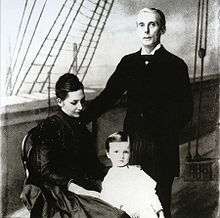Richard Pope-Hennessy
Major-General Ladislaus Herbert Richard Pope-Hennessy CB DSO (1875 – 1 March 1942) was a British Army officer and Liberal Party politician of Irish Catholic descent.
Richard Pope-Hennessy | |
|---|---|
 Richard Pope-Hennessy in 1927 | |
| Born | 1875 |
| Died | 1 March 1942 |
| Allegiance | United Kingdom |
| Service/ | British Army |
| Rank | Major-General |
| Commands held | 4th Battalion, King's African Rifles 1st Bn, the Oxfordshire and Buckinghamshire Light Infantry 50th (Northumbrian) Division |
| Battles/wars | Second Boer War First World War |
| Awards | Companion of the Order of the Bath Distinguished Service Order |
Background

He was the eldest son of Sir John Pope-Hennessy MP, of Rostellan Castle, County Cork and Catherine Elizabeth Low. He was educated at Beaumont College.[1]
Military career
Pope-Hennessy was commissioned into the Oxfordshire Light Infantry in 1895.[1] He was deployed to South Africa and served with the West African Frontier Force during the Second Boer War.[1] He subsequently became commandant of the 4th Battalion, King's African Rifles in 1906 for which service was appointed a Companion of the Distinguished Service Order in 1908.[1]
During the First World War he became commanding officer of the 1st Battalion the Oxfordshire and Buckinghamshire Light Infantry in Mesopotamia in 1916 and then became a staff officer with the British Indian Army in 1917.[1][2]
After the war he served as a staff officer at the War Office and then was Military Inter-Allied Commissioner of Control in Berlin. Subsequently he spent three years as military attaché in Washington D.C.[3] He became General Officer Commanding 50th (Northumbrian) Division in 1931 before retiring in 1935.[4]
Pope-Hennessy published a number of books an articles on military matters and in one of them he predicted the technique of the German Blitzkrieg.[2]
Political career
He took particular interest in military matters and in issues affecting his native Ireland. In 1919 he had published 'The Irish Dominion: a Method of Approach to a Settlement'.[1] He was Liberal candidate for the Tonbridge Division of Kent at the 1935 General Election. Tonbridge was a safe Conservative seat that they had won at every election since it was created in 1918. The Liberal Party had not fielded a candidate at the previous General election and he was not expected to win and finished a poor third.[5]
| Party | Candidate | Votes | % | ± | |
|---|---|---|---|---|---|
| Conservative | Rt Hon. Herbert Henry Spender-Clay | 23,460 | 61.3 | ||
| Labour | F M Landau | 9,405 | 24.6 | ||
| Liberal | Ladislaus Herbert Richard Pope-Hennessy | 5,403 | 14.1 | ||
| Majority | 14,055 | 36.7 | |||
| Turnout | 68.2 | ||||
| Conservative hold | Swing | ||||
Family
He married, in 1910, Una Birch a writer, historian and biographer. They had two sons,[1] James who became a writer and John an art historian.[6]
Death

He died in 1942 and is buried alongside his wife at Friary Church of St Francis and St Anthony, Crawley.[7]
References
- Thom's Irish who's who. Alexander Thom. 1923. p. 208.
- James Wassermann (ed.): Secret Societies: Illuminati, Freemasons and the French Revolution. Nicolas Hayes, 2007, ISBN 978-0892541324, pp. 49-50
- The Times House of Commons, 1935
- "Army Commands" (PDF). Retrieved 1 June 2020.
- British parliamentary election results 1918-1949, Craig, F. W. S.
- Quennell, P., Introduction to A Lonely Business – A Self-Portrait of James Pope-Hennessy, 1981, p. xv.
- "Ladislaus Herbert Richard Pope-Hennessy". Find A Grave Memorial. Retrieved 2 June 2020.
| Military offices | ||
|---|---|---|
| Preceded by Henry Newcome |
GOC 50th (Northumbrian) Division 1931–1935 |
Succeeded by William Herbert |